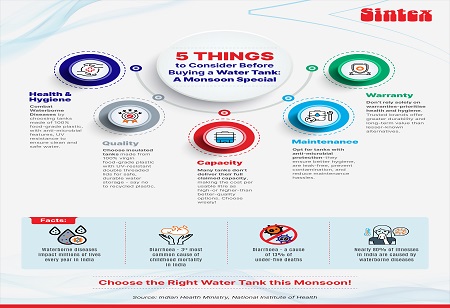
Rain offers welcome relief from the summer heat—but it also brings a sharp rise in contamination risks, particularly in how water is stored at home. Public health data from the National Centre for Disease Control (NCDC) show a seasonal increase in diarrheal and waterborne illnesses during the monsoon months, often linked to exposure through untreated or improperly stored water.
High humidity and low sunlight create the perfect condition for microbes to thrive inside storage tanks. And yet, despite the fact that these tanks supply water for drinking, cooking, and bathing, most households rarely check if they’re equipped to keep that water clean.
Here are five things that matter. Every one of them becomes more important while choosing water tanks during the rainy season:-
1. Health & Hygiene – Combat Waterborne Diseases
Cholera, typhoid, and hepatitis A cases are on the rise during monsoons – these affect a large section of the population each year. Diarrhoea is the third most common cause of childhood mortality in India, claiming nearly 13 percent of lives in children under five years of age. Thus the cause is almost always the same – unclean water, lack of sanitation and hygiene, and inefficient storage.
A well-built tank must help reduce health risk. Look for tanks with anti-microbial layers – these coatings help prevent the spread of microbes (algae, bacteria, fungi and virus) and keep the water safe for daily use. In fact, tests conducted under ISO 22196 standards (Measurement of antibacterial activity on plastics and other non-porous surfaces) show that antimicrobial-treated surfaces can reduce common pathogens like E. coli and Salmonella by over 99% within 24 hours, as cited by global hygiene specialists such as Microban.
Also Read: World Environment Day 2025: India's Real Estate Sector Anchors the Green Transition
It is best to avoid tanks made from recycled plastic. While they are cheaper, these tanks release micro-plastics into the water that are harmful for health. Tanks made from 100 percent food-grade virgin plastic are safer and healthier.
Another issue is sunlight—or the lack of it. Cloudy skies and humidity encourage microbial growth. Ensure that the tank lid is also equipped with anti-microbial protection, as sunlight often enters from the top — making it a critical point where microbial growth can begin.
Invest in a good quality tank that has been tried, tested and trusted since decades – a tank that promises clean water and good health for your family.
2. Quality – Choose Durability and Insulation
Harsh climate can cause tanks to weather faster. Constant rain, gusty winds, and sudden fluctuations in temperature cause lower-grade recycled tanks to crack or leak.
A good quality water tank is tough on the outside and safe on the inside. It is a myth that a heavy tank is sturdy and durable. Look for a tank that is made using 100% food grade virgin plastic across all its layers. In many cases, only the inner or outer layer is made with food grade material — ensure all layers meet this standard for complete safety. Completely avoid tanks made with recycled plastic as it poses huge health risk as it may have been mixed with toxic chemicals & phthalates. Mechanical strength reduces with the number of times the source material is recycled — a fact often unknown to buyers at the time of purchase. To compensate for this loss in strength, manufacturers may add calcium carbonate and other fillers, which are harmful chemicals and can compromise the safety and durability of the tank. Also tanks with threaded lids prevent contaminants from entering and discourage tampering.
Always choose tanks that are ISI marked and certified by a NABL-accredited lab. BIS-certified water tanks conform to IS 12701 standards, which ensure durability, UV resistance, and non-toxic materials. This certification guarantees the tank has passed safety and quality tests critical for long-term water storage.
Always opt for one that offers temperature control, health & hygiene protection, and is built by a manufacturer who committed to never compromising on quality.
3. Capacity – Select the Right Size for Consistency
Water needs change during monsoon. Supply is less predictable. Demand goes up. A tank that runs dry too quickly—or sits full and unused—will not prove to be effective.
Smaller households (family of 2) can usually manage with 500 to 1,000 litres. Larger families (family of 2+) or multi-storey homes may need 1,500 litres or more. In areas where water cuts are common, some extra storage can make a real difference. Different types of storage tanks are available today —loft, overhead, and underground. Choose the one that best suits your home’s structure and water needs.
Also, look beyond the label. As noted earlier, many tanks fall short of their claimed capacity. There’s also a cost issue that’s easy to miss. Some brands advertise 1,000-litre tanks, but the real useable capacity may be closer to 850 or 900 litres (from inlet to outlet). When you pay based on the stated capacity, that gap adds up. In many cases, the actual price per usable litre is the same or higher than a better-quality tank.
Also Read: Why Nature-Inspired Spaces Are the Future of Architecture?
 4. Maintenance – Hassle-Free Long-Term Use
4. Maintenance – Hassle-Free Long-Term Use
A tank that’s hard to clean will eventually be ignored. During monsoon, this problem gets worse. Always choose tanks that have anti-algae, anti-bacterial, anti-viral, anti-fungal, and UV-resistant properties to ensure better hygiene and reduce maintenance hassles. Tanks which come with these advanced are leak free and prevent contamination. All these lead to easy maintenance of the water tank.
Water tanks should be cleaned at regular intervals—ideally every three to six months. During maintenance, inspect the inner walls for cracks, ensure the lid seal remains intact, and verify that the outlet is free from blockages. A design that allows for easy access and cleaning significantly improves the likelihood of consistent upkeep.
5. Warranty – Secure Your Investment
Don’t just rely on the warranty—look beyond and prioritise health and hygiene as essentials while buying a tank. Trusted legacy brands with proven quality often last longer and deliver far greater long-term value & benefits than ordinary brands.
Warranties ranging from three to 15 years are standard in the industry and should cover issues such as UV degradation, structural damage, and manufacturing defects. Manufacturers that offer clear, long-term warranty terms generally demonstrate greater confidence in their materials and design.
Many fall for guarantees, only to pay 2000-2500 (almost 1/3rd cost of a tank) or later for replacements—adding to lifetime costs without any health benefits. Premium benefits come with a little cost, but they save you more in the long run.
In the event of a failure or defect, a strong warranty can reduce replacement costs and provide long-term peace of mind.
The Bottom Line
During the monsoon, your water tank becomes more than just a container. It becomes a barrier between your family and contaminated water. What it’s made of, how it’s built, and whether it can be cleaned or fixed without a struggle—all of that matters.
Choose carefully. Safe water starts with a safe tank.
About the Author: Yashovardhan Agarwal is the Managing Director of Welspun BAPL and a Director at Sintex BAPL, leading the plastics division to expand from traditional water tanks into integrated water management and premium infrastructure products. Under his leadership, Sintex has focused on innovation, launching India’s first antimicrobial CPVC pipes and investing in new manufacturing plants across multiple states.
We use cookies to ensure you get the best experience on our website. Read more...
Copyright © 2025 HomesIndiaMagazine. All Rights Reserved.